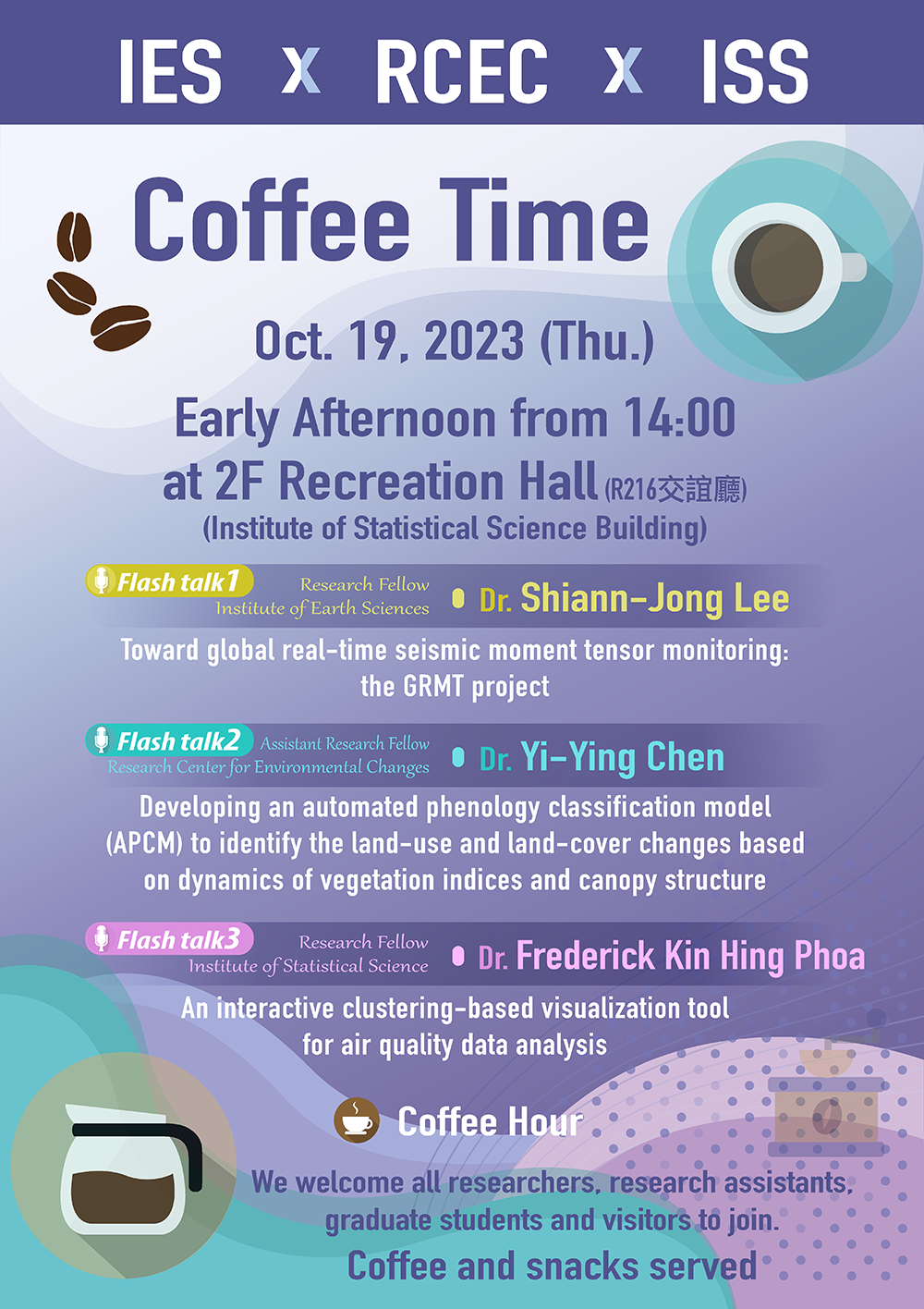

2023.10.19 14:00-16:00
2F Recreation Hall (R216), Institute of Statistical Science Building
Dr. Shiann-Jong Lee(IES) / Dr. Yi-Ying Chen(RCEC)/ Dr. Frederick Kin Hing Phoa(ISS)

Title and abstract:
Title: Toward global real-time seismic moment tensor monitoring: the GRMT project
Dr. Shiann-Jong Lee, Research Fellow, IES
Abstract:
Title: Developing an automated phenology classification model (APCM) to identify the land-use and land-cover changes based on dynamics of vegetation indices and canopy structure
Dr. Yi-Ying Chen, Assistant Research Fellow, RCEC
Abstract:
Taiwan’s geographical location, simultaneously residing within the subtropical and tropical climate zone, and regional diversity in topography result in a diverse range of climate, precipitation, and temperature suitable for the cultivation of different crops. Diverse vegetation cover and land-use have posed challenges to the accuracy of land-use classification through multispectral remote sensing images. For example, paddy fields and dry agricultural land misclassification (paddy fields as water; dry agricultural land as bare soil) and irrigation pond area uncertainty, caused by weather, algal bloom, and management, are some reasons causing classification errors in Taiwan.
In this study, we utilized the advantage of land-cover seasonality change and established an Automated Phenology Classification Model (APCM), classifying SPOT images, based on phenology, into a total of six land-cover types – forest, built-up land (including bare soil), water, agricultural land, grassland/shrubs, and unknown/unclassified. Through analysing monthly Normalized Difference Vegetation Index (NDVI), and Near Infrared (NIR) values, the temporal characteristics of each land type are detected and used as indexes of classification. 2013-2022 classification results of Taoyuan, Taiwan, demonstrate land area fluctuations over the years – with stable forest and water area change, overall slight decline in agricultural land, and increase in grassland/shrubs. The results also show a negative correlation in area change between grassland/shrubs and agricultural land, and a positive correlation between irrigation ponds and agricultural land. APCM aims to alleviate the time and effort of manual classification. The temporal transferability of the model facilitates analysis of long-term trends of land-use and land-cover change (LULCC), and the spatial transferability enables the classification of Taoyuan to be extended to the entire extent of Taiwan.
Title: An Interactive Clustering-Based Visualization Tool for Air Quality Data Anlysis
Dr. Frederick Kin Hing Phoa, Research Fellow, ISS
Abstract:
Examining PM2.5 (atmospheric particulate matter with a maximum diameter of 2.5 micrometers) seasonal patterns is an important research motivation for environmental scientists. An improved understanding of PM2.5 seasonal patterns can help environmental protection agencies (EPA) make decisions and develop complex models for controlling their concentration in different regions. This work proposes an R Shiny App web-based interactive tool, namely “model-based time series clustering (MTSC) tool,” for clustering PM2.5 time series data using spatial and population variables and their temporal features, such as seasonality. Our tool allows stakeholders to visualize important characteristics of PM2.5 time series data, including temporal patterns and missing values, and cluster by attribute groupings. We apply the MTSC tool to cluster Taiwan’s PM2.5 time series data based on air quality zones and type of stations, and thereby reveal an improvement in Taiwan’s air quality since 2017. Our analysis also isolates southern Taiwan from other air quality zones due to a large difference in seasonality patterns, allowing EPA experts to execute different but effective air quality policies for different zones. This is a joint work with my former postdoc Dr. Mahsa Ashouri (University of Michigan - Ann Arbor), my master student Mr. Bo-Wu Chen (National Taiwan University), and my collaborators Dr. Chun-Houh Chen (Institute of Statistical Science, Academia Sinica) and Dr. Galit Shmueli (National Tsing Hua University).